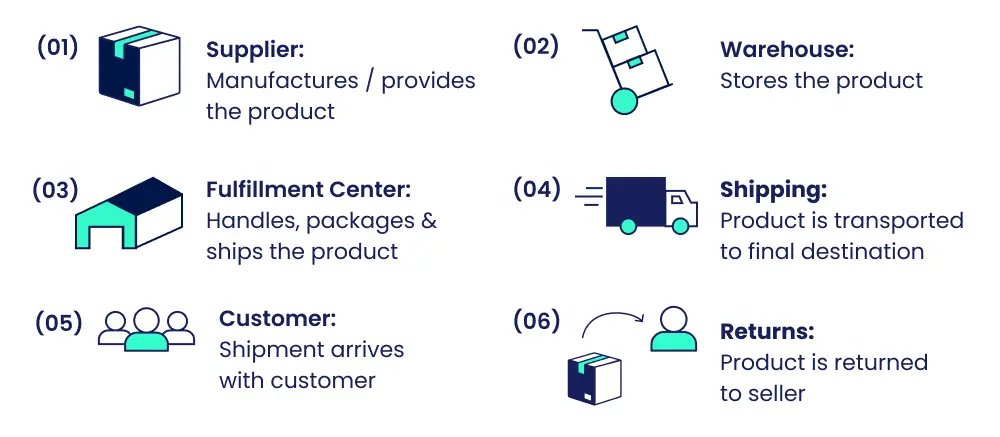In eCommerce there are few things as important as having a robust and healthy supply chain. This means the process of sourcing, packaging, storing, shipping and everything in between that a product goes through. A supply chain can be the backbone of a thriving online retail business, ensuring that customers always have a full stock of products to choose from. For this to remain the case, it is important to develop a deep understanding of the nuts and bolts that make up an eCommerce supply chain. Optimizing it as well as possible can cut costs, increase profits, and result in better long-term competitiveness for an online retail business.
What Exactly Is a Supply Chain?
A supply chain is the collection of steps that it takes to get a product from the supplier to the seller and then to the customer. Every supply chain is different and involves several distinct steps. Some companies ship internationally, which means their supply chains have to account for import bureaucracy. Others need to organize the manufacturing of their products, sourcing raw materials and managing their assembly in factories.
A major part of any eCommerce supply chain is the final shipment directly to the customer, which is known as Last mile delivery. Online retailers rise and fall based on how well, or poorly, they run this entire process. It can make the difference between a product arriving with the customer on time, or facing major delays all throughout its journey. These can be very costly as they seriously drain revenue.
A core component of any supply chain is the management thereof. No matter how well planned your business’ logistics are, it will take constant and capable management to deal with all the unforeseen factors that can and will emerge. Good management means responding to issues quickly and effectively, great management means solving problems before they even emerge. If processes, such as a product being shipped on time, aren’t supervised adequately, they can fall behind schedule.
What Causes a Supply Chain to Struggle?
Especially in the eCommerce world, supply chains face countless unforeseen challenges that simply have to be dealt with. One of the most common issues is a shipment from the supplier being delayed. This can be due to poor management or simply a new import procedure that takes longer to deal with than usual. But any process in the supply chain can face hiccups.
Shipments can get lost, delayed or broken. Factory, dock, airport, or any kind of workers involved in shipping can go on strike. There can be shortages that affect the supplies needed to make a product. Extreme weather conditions can block roads or railways, causing major delays. Even geopolitical issues can have a major impact on supply chains. The COVID-19 pandemic and 2022 Russian invasion of Ukraine caused huge disruptions to trade across the globe, resulting in countless companies facing significant delays in sourcing and shipping their products.
Famously, Sony’s Playstation 5 saw huge shortages due to the company not being able to source enough components, especially microchips. When a container ship famously got stuck in the Suez Canal for six days it caused billions in financial damage due to lost trade. The possibilities for disruption are endless. No matter how big or small you are, a healthy supply chain means a healthy business.
The Structure of an ECommerce Supply Chain
Subscribe to the eCommerce newsletter for
top industry insights

Supplier
A supplier is a business that provides an eCommerce seller’s products, whether by assembling or sourcing them. Often located abroad, in places like China, the supplier represents the beginning of your supply chain. When finding a supplier you need to make sure that you choose someone that is reliable. Nothing clogs up a supply chain like freight that doesn’t leave on time, especially because this usually takes place in a foreign country, which makes everything harder to oversee for a seller. Once you have a supplier you are satisfied with, you should foster a good relationship with them in order to gain benefits like better price rates or an improved shipping service.
Warehouse
A cost-effective solution for storing products short or long-term, warehouses are necessary to hold onto your stock until the online orders come in. They allow for a faster delivery of products to customers, as they store them in a location from which shipping to customers is faster. Warehouses become more and more important as your eCommerce business grows and you amass a bigger amount of inventory that has to be stored and shipped. Finding a good warehousing partner is crucial as a good rate for storage can allow you to bring in larger shipments to ensure that stockouts don’t happen and customers can buy your products without disruption.
Fulfillment center
Managed by companies like Amazon, these take care of sorting, managing, packaging and shipping products to consumers. Fulfillment centers are ideal for fast shipments of goods, better customer service, for example by handling returns and offering support via email or phone, and perks like customized and improved packaging. In general, fulfillment centers provide an eCommerce seller with more options for their delivery process, while making it more reliable, allowing them to focus their energy elsewhere.
Shipping
This is the process of delivering products to their destination. In essence, the faster this is done, the better, as customers increasingly expect to receive products they bought shortly after ordering. Besides delivery times, it is important that packages arrive in good condition. Fragile goods need to be packed accordingly or even the most streamlined eCommerce supply chain can end in disappointment for the customer. An ideal shipping partner also offers good tracking options for you and your clients.
Customer
The final step of the delivery process is when products are delivered to the customer. What matters most to customers is an easy to use and engaging online store and a fast delivery process. Offering them two good experiences here has a major impact on whether they will return as customers. Bad experiences in this regard might prevent them from doing so, even if they liked the product. The better experience you give a customer with your store, the more likely they are to purchase from it again.
Returns
If a customer is unhappy with the product, you will need to organize its return to the seller, as well as a refund. This process is obviously avoided as best as possible but it is important for two major reasons: 1) to maintain good relations with the customer and 2) to learn about what went wrong and can be improved upon. If there is a problem with the product that is due to an issue in the supply chain, you need to resolve it immediately, to ensure that you don’t face more returns for this reason.
The goal of every eCommerce supply chain is to source a product, transport it to a storage area and then ship it to the customer when an order comes through. Ideally, it is a self-fulfilling cycle, in which sales from sold products pay for the next batch.
The process always starts with the supplier, who builds or assembles the product you want to sell. From here it is sent to a warehouse where it is stored. Next, it is transported to a fulfillment or distribution center, which handles shipping to the customer. If the customer is unhappy with their purchase for any reason, the seller also has to manage the return and refund process.
Every eCommerce business has its own structure; some don’t keep any stock on hand and have products sent directly from suppliers to customers, which is called drop shipping. That means they save on several operational costs but their profits, which are the difference between a product’s wholesale and retail price, also remain slim. On the other hand, certain eCommerce retailers organize the manufacturing of their products, sourcing raw materials and managing their assembly in factories. Other businesses prefer not to use fulfillment centers and take care of packaging and shipping themselves. You need to understand the goals and needs of your business and structure your supply chain accordingly.
ECommerce Supply Chain Management
The product’s journey from manufacturing to shipping needs to be managed carefully, as many factors can emerge to delay its arrival at the destination. This is where expert and hands-on eCommerce supply chain management makes the difference. You need to be on top of all details, no matter how big or small. The flow of information, money and resources has to be overseen at all times to ensure that your goods move through each supply chain stage without holdups.
If, for example, a vital detail, such as a new warehouse location, isn’t communicated to a supplier, you can lose huge amounts of time and money correcting this mistake. Similarly, a fragile product that isn’t packaged appropriately can break during transport. Details that might appear small at first can have huge consequences on the success of your business. Things like not having the right insurance, missing a detail regarding import laws or errors in the inventory-counting process can turn out to be extremely costly.
Trying to prevent issues is a good start, but problems will emerge sooner or later. What is important is that the response is quick when they do. Speed is everything in this industry; identifying and resolving an issue right away can save huge sums further down the road. This means keeping a constant eye on operations and closely tracking shipments.
Pro tip: find a supplier that allows you to track your freight so you can respond quickly if something happens. This is where picking the right partners comes in. Sometimes it’s worth it to hire a company that helps with your logistics, known as a 3PL (third party logistics provider), as this can avoid some major headaches.
Ensuring that shipments flow in and out without delays is crucial. But you can aim even higher. Great eCommerce supply chain management involves constantly looking to innovate, whether by reinvesting profits to scale your operation or streamlining the order-to-delivery process. If you see that a product is selling out frequently, you might want to invest in larger or more frequent shipments. Perhaps you can use profits to hire a more effective delivery company that reduces shipping times. There is always room to grow, and you shouldn’t be afraid to have big aspirations and follow through on them.
What Differentiates an ECommerce Store From a Physical Shop
An eCommerce supply chain is significantly different from that of a traditional brick-and-mortar store. Online retailers are limited to a virtual shopping experience, whereas physical stores have their own distinct aesthetics, store layouts, employees and offer the ability to see and touch products before purchase. All of this creates a noticeable connection with customers.
ECommerce companies offer two main experiences: navigating their online store and receiving their delivery. This means that things like product availability, convenience, and shipping times become extremely important. If an eCommerce supply chain is managed badly, it can significantly affect these factors, which decide whether a customer chooses to return or not.
One advantage that online retailers do have is fewer costs than their physical counterparts. A 2017 study conducted by the Wall Street Journal and Onestop Internet Inc. found that high-end fashion eCommerce retailers see almost twice the profit margins of brick-and-mortar stores. The latter face operating costs such as store rent and payroll that online shops don’t need to deal with. This allows them to focus on important matters, such as their supply chain.
Why Is the Supply Chain So Important?

Some sellers underestimate how crucial an effective eCommerce supply chain can be. Perhaps you feel that marketing and selling your products should be the focus of your eCommerce business. While those are certainly key elements, a poorly managed supply chain can derail a project that is otherwise thriving. How? Let’s say you have a product that is flying off the digital shelves. This is great, in theory. However, if you run out of stock before your next shipment is on its way you could run into noticeable issues. For example, Amazon can start ranking your product lower on its search results. In the worst-case scenario they can even remove it entirely.
Popular content
- 14 strategies to improve your eCommerce business’s financial health
- 50+ ChatGPT prompts to elevate your eCommerce business
- A guide to pricing your product on Amazon
- 5 marketing metrics all eCommerce businesses should track
- All about Amazon PPC
This may seem unfair or frustrating but Amazon has a strong incentive to do so. When a potential customer seeks a product and discovers that it’s out of stock, they will either 1) buy from a different seller, 2) go to another website and buy from there, 3) postpone buying this product, or 4) decide not to buy it at all.
Except for the first option, all of these outcomes are bad for Amazon, so it will do whatever it takes to prevent them from happening. That means ensuring that your product is less visible to customers, which will hurt your sales, even when you eventually do restock. Other online storefronts can behave similarly, so keeping your eCommerce supply chain in good shape should always be a priority.
Ways to Keep Your ECommerce Supply Chain Running Smoothly
Understand and predict market trends
One of the best ways to maintain your eCommerce supply chain is to continuously ensure that your next shipment isn’t far away when stock starts to run low. It is crucial to plan ahead and understand market trends that might affect your sales. For example, if you are selling pens or notebooks, the end of summer, when school starts again, can mean a surge of new purchases. That means you need to stock up and do your best to predict how much inventory you’ll need. Running out of a product at this time can mean a major loss of revenue.
You should always keep an eye on market behavior. A new fad can emerge extremely fast, especially if it goes viral on social media. Remember when fidget spinners burst onto the market in 2017? The businesses that reacted quickly saw the biggest profits. However, this event also taught another valuable lesson in supply chain management: beware of overstocking when demand is falling. The enthusiasm for fidget spinners died down as quickly as it started, meaning retailers risked finding themselves with bloated inventories that wouldn’t sell at a cost-effective pace. Ideal eCommerce oversight involves tailoring your supply shipments to the latest market trends.
Use metrics to your advantage
Tracking your eCommerce supply chain metrics is going to be an essential part of your business’ growth. For example, Perfect Order Rate shows how many orders go through without any issues. It can provide insight into inefficiencies that can be ironed out and might have been missed otherwise. You can see how different shipments and products perform, providing a deeper understanding of logistical errors that happen on the way.
The Cash-to-Cash Time Cycle provides insight into how much time passes between the moment you pay your supplier to the moment your customer pays you. This is crucial for understanding the performance of your business, and whether your capital is tied up by inefficient processes.
Additionally, looking at Inventory Turnover, which shows how many times you sold and replaced your stock, over the course of a year can show how good your business is at quickly selling products. This is important as it affects how much you are spending on warehouses. A quick Inventory Turnover also means that an online retailer is less likely to resort to discounts in order to free up their stock.
There are several eCommerce services that are tailored to providing online retailers with the best metrics available. Using some of these can provide you with the insights you need and help you understand how metrics can work in your store’s favor.
Rethink your current supply chain conditions
One good way to cut costs is to renegotiate with your supplier. Perhaps they agree to a better rate now that you’ve been with them for a long time and are likely to stick around. You might also be able to agree on a better price if you increase your order size or transfer the full payment up front. Alternatively, you can negotiate for other factors that might increase sales, such as faster shipping, a better warranty, or improved packaging for the products.
You should also take a look at alternative suppliers and their prices, which you can use as a bargaining tool to lower your prices, or simply switch over. Similarly, you should always keep a close eye on warehousing and fulfillment costs and whether alternative partners might be beneficial. Besides getting a lower price, you might find a better option with perks like improved shipment tracking or faster delivery times.
Inject growth capital to scale your business
With more capital in your hands, you can boost your company’s productivity in multiple ways. From being able to get larger shipments of inventory at a better price to ensuring that your stock never runs low, it can make your eCommerce supply chain more robust than ever.
8fig offers a Growth Plan that is customized to your company’s needs and plans. Dynamic and highly adaptable, it ensures you get a cash infusion when you need it and don’t send remittances until you’re making money back from sales again. With this kind of cash infusion, you can invest in more regular shipments without needing to wait for revenue from sales. Check out 8fig and discover how you can take your business to the next level today.
Subscribe to the eCommerce newsletter for
top industry insights
to our blog
Read the latest
from 8fig

AI is quietly reshaping eCommerce. Karma’s Hadas Bar-Ad explores how today’s sellers are using intelligent tools to streamline operations, boost efficiency, and drive smarter growth.

WhatsApp isn’t just for memes and group chats anymore. With a 98% open rate, it’s the secret weapon your eCommerce marketing strategy might be missing. Here’s how to do it right.

Stuck with extra inventory after Amazon’s Spring Sale? Learn five smart strategies to clear unsold stock, boost cash flow, and avoid future overstocks with smarter inventory planning.
